
The Tabernacle of Moses – God’s Heavenly Pattern for our Spiritual Transformation – Part V: The Most Holy Place
THE HOLY OF HOLIES
The Outer Court of the Tabernacle, as viewed by someone approaching it, would appear as a privacy fence fifty cubits (3) (72.9 ft/22.3m) wide by one hundred cubits (145.8 ft/44.5m) long by five cubits (7.3 ft/2.3m) high made of fine (i.e., with a high thread count per inch) white linen supported by bronze posts (twenty on the long sides and ten on the short sides) with bronze bases and silver caps on top (Exodus 27:9-15). Also, there were silver hooks on the posts for attaching the linen and bronze stakes for cords to support the posts on both sides (Exodus 27:17-19).
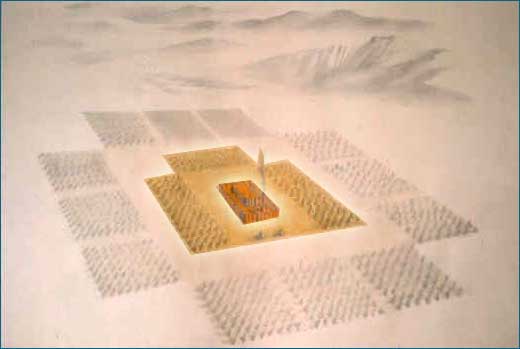

Realize, you would see this white fence, with a cloud of smoke rising from the center of it, after passing through the many dark tents of the children of Israel camped around it. What a remarkable contrast!
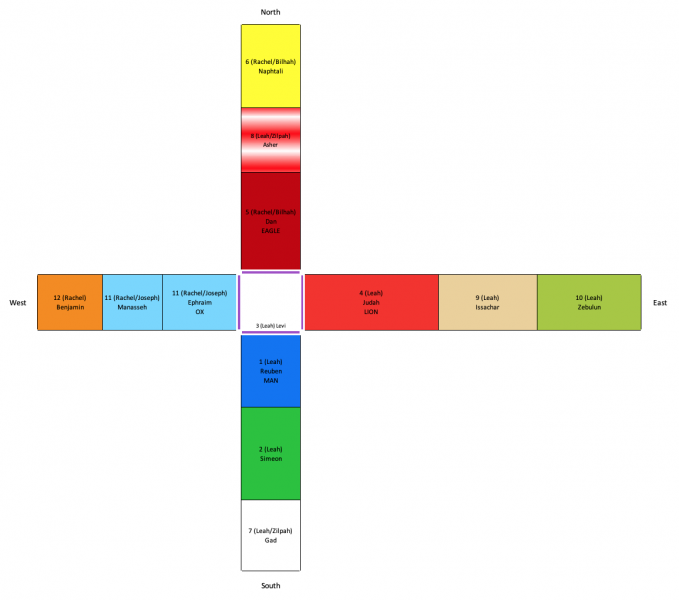
The figure above graphically depicts how Israel was instructed to camp (Numbers 2:1-34) with the width (East and West) or height (North and South) of each tribe corresponding to its population. This arrangement of the tribes forms a cross’s shape (1) with its base to the East. There is some deviation from the Breastplate order as the tribe of Levi is in the middle of the camp around the tabernacle, and the tribe of Joseph is replaced with his two sons Ephraim and Manasseh, effectively giving the tribe of Joseph a double portion in the promised land.
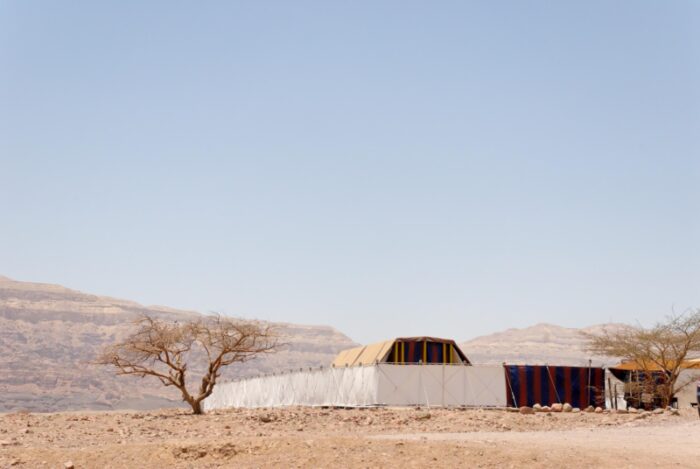
Again, approaching the outer court of the Tabernacle of Moses, one would see the bright white linen (1) symbolically representing God’s high standard of purity or righteousness (Revelation 19:8) and would be convicted of sin (Romans 3:23).
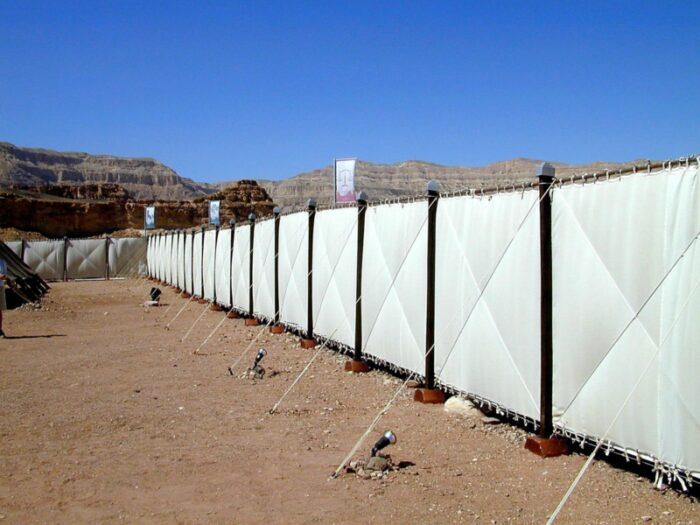

The outer fence of the Tabernacle had bronze posts (representing God’s judgment due because of our sin) placed on top of the soil (representing all humanity, Genesis 2:7). The silver (1) on the top of the posts represents there is a “price on our head” for redemption that must be paid (Numbers 18:16. Exodus 30:16) to make us righteous (Romans 3:24-26). Our ability to become righteous once this price is paid by the blood of Jesus (1) (symbolically represented by the silver hooks supporting the white linen) and able to escape the fiery judgment that we deserve (symbolically represented by the bronze post and base Numbers 21:8,9). That is, the message of sin, righteousness, and judgment is conveyed to anyone approaching the Outer Court via the materials and construction of the Outer Court’s fence or wall (John 16:8-11). The wall’s message – which represents the law – you must be perfect for entering the Tabernacle Complex and approaching a Holy God! The only way to become perfectly righteous is to accept Jesus as Lord and Savior (1)

The curtain gate on the East side is the only entrance (i.e., The Way) into the Tabernacle’s Outer Court. The Outer Court represents the Body of man (1 Thessalonians 5:23). The curtain made a relatively wide gate (i.e., wide in comparison to the wall width but still narrow in comparison to the world – Matthew 7:13,14) that was twenty cubits (29.2 ft/8.9 m) in width made of white linen with blue, purple, and scarlet thread woven into it and suspended by four bronze (1) posts (Exodus 27:16). The four posts supporting the curtain gate represent that this entrance is available to all, even to the Earth’s four corners (1 John 2:2. Revelation 20:18). White is the color of purity, blue is the color of Heaven and divinity, purple is the color of royalty, red is the color of blood. Together they symbolically represent that “The Way” into the Tabernacle will be by ONE who is sinless and both God from Heaven (John 3:31) and King (John 18:37) that paid the price for our redemption with His pure and righteous blood (Mark 10:45. Revelation 1:5). Only one person has fulfilled those requirements – JESUS (1 Corinthians 15:3,4). The Curtain Gate being so brightly colored made it very clear that this was the Tabernacle entrance. The gate’s message is that a way of grace has been made by Jesus so that all may enter (1 John 2:2). Therefore, the Outer Court’s curtain gate symbolically represents Jesus as “The Way” (John 14:6).
We spiritually enter His gates to the Outer Court with Thanksgiving (i.e., singing songs that thank God for what He has done for us). (Psalms 100:4)

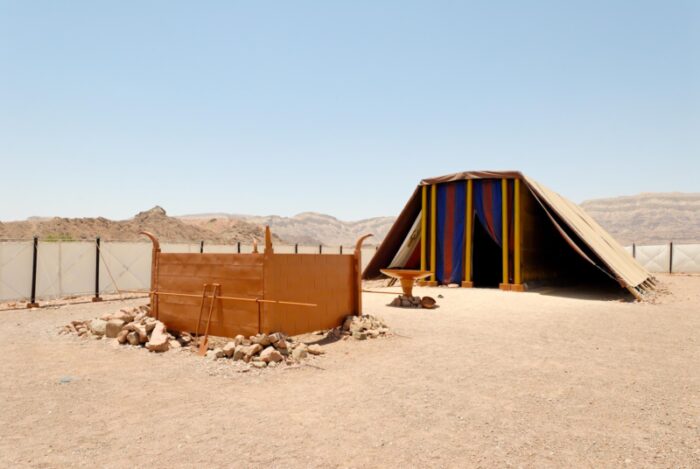
Upon entering the Tabernacle’s Outer Court, you would pass the Brazen (bronze) Altar (1). It was five (the number symbolic for grace, God’s unearned favor) cubits square and represented our Lord Jesus’s cross where He took the fiery judgment for our sin (Isaiah 53). Interestingly, when describing the construction of the tabernacle, God said the Brazen Altar was “Most Holy” four times (Exodus 29:37;30:10;30:29;40:10) where He only said it once about the Golden Altar of Incense (Exodus 30:36). That is, Jesus the Son of God’s sacrifice on the cross was very, very, very, very sacred to God the Father and, again, it is available to all that will accept it by faith to the four corners of the earth (Romans 10:13. Romans 10:9,10).

Unfortunately, some will enter the Outer Court learning about the Altar only with their mind but never believing it with their spiritual heart (Romans 3:23-25. Hebrews 4:2). Furthermore, they can blend in with the other Christians “talking the talk” and think that they are saved because “We” (i.e., those genuine Christians they are with) are doing the Lord’s work even though they individually are not. Realize, God is interested in “You” and your personal relationship with the Lord Jesus and not simply the “We” of the company that you keep (Matthew 7:22,23). No religious practices, family, or friends can save us – only a personal relationship (1) with God the Father by God Jesus Christ His Son facilitated by God the Holy Spirit.
Others may enter the Outer Court and then choose to leave; however, some will return and be saved by accepting Jesus as their personal SAVIOR (John 3:16-18. Acts 26:18). Unfortunately, others will decide to never return and will be eternally condemned (1) (Hebrews 10:26-39). Some that have initially laid down their lives at the Brazen Altar will choose to go back to living their lives instead of deciding to live for Jesus at the Bronze Laver. Consequently, they will experience very little of Jesus’ ministry in their life. They will be left to stroll around in the Outer Court dependent upon natural illumination and never have the illumination of the Holy Spirit found only in the Holy Place. A Christian in this condition cannot understand deeper spiritual truths (1 Corinthians 3:2. Hebrews 5:12-14).
Interestingly, the Tabernacle’s outer wall was 100 cubits in length, 50 cubits in width, and 5 cubits in height (Exodus 27:18). If we add the two longer walls (100+100) to the two shorter walls (50+50), we find that the Tabernacle Courtyard had a perimeter of 300 cubits. Furthermore, if you multiply 300 cubits by 5 cubits (the wall height), we find that the wall was 1500 square cubits. The Courtyard had the Bronze Basin and the Brazen Altar, where Jews brought their ritual sacrifices to God. In other words, the Courtyard represents the Age of the Law and Prophets. From Moses receiving the Law on Mount Sinai to the resurrection of Christ was approximately 1500 years. The Most Holy Place had dimensions of 10x10x10 or 1000 cubic cubits. Perhaps this represents the Millennial Kingdom of Christ which will last a thousand years. During this time, Jesus Christ, the living bread from Heaven, will rule and reign from the Mercy Seat in Jerusalem with a rod of iron. He will write His Law on our hearts, and the lion will lay down with the lamb. The Holy Place was 20 cubits long, 10 cubits wide, and 10 cubits high or 2000 cubic cubits. The Holy Place contained the Table of Showbread (the Lord’s Supper), the Altar of Incense (the prayer of the saints), and the seven-branched Lampstand (typifies the Church in the book of Revelation). Perhaps the Holy Place represents the Church Age meaning that it will be approximately 2000 years (1) in duration. Enough speculation… back to the teaching.
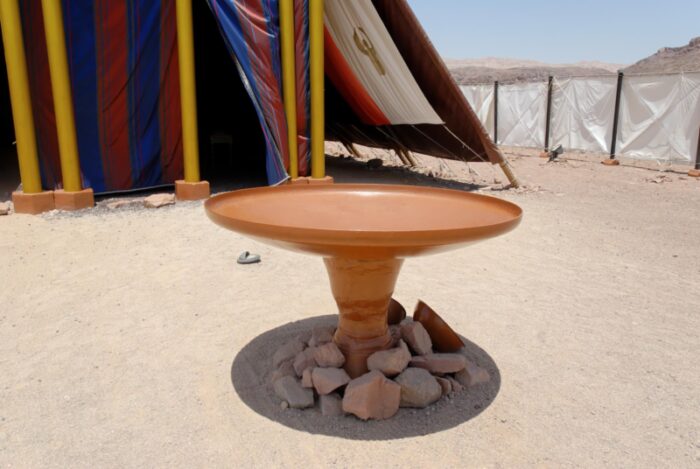
Some that have been saved or born again at the Brazen Altar will decide to move forward to the Bronze Laver (1), where they choose to yield to Jesus as LORD in their spiritual heart’s and thus allow the Word of God to purify and separate them to God as they live for Him. That is, Jesus, you died for me (symbolized by the Brazen Altar), and now I will live for you (symbolized by the Bronze Laver). Only those that have yielded to Jesus as both SAVIOR (symbolized by the Brazen Altar) and LORD (symbolized by the Bronze Laver) will be able to enter into the Holy Place (Matthew 7:14).
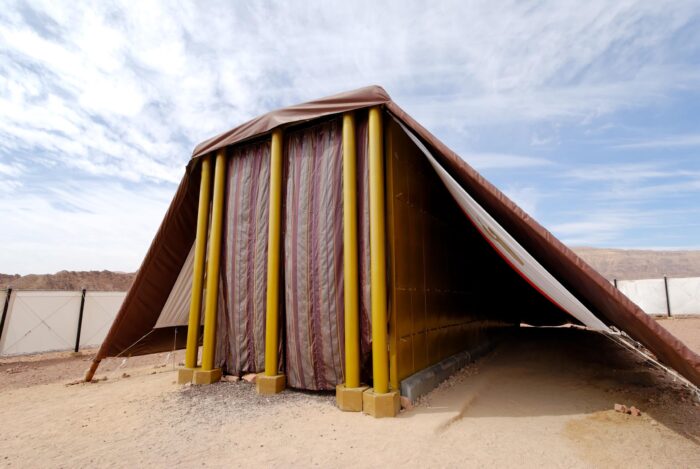
The curtain screen or entrance of the Holy Place is woven with the same color scheme as the entrance to the Outer Court. That is white linen with blue, purple, and red thread weaved into them (Exodus 26:36,27. Exodus 36:37,38). However, five (symbolic number for grace) posts or pillars support the linen screen at the Holy Place’s entrance. Furthermore, these posts are acacia wood (1) covered with gold (1) and gold caps on top but with a bronze base. Recall the posts at the entrance were bronze with silver caps and bronze bases. The Outer Court entrance posts symbolized our sinful condition that deserved God’s fiery judgment (bronze); however, a price could be paid for our redemption (silver). The Holy Place entrance posts are gold with gold caps representing that we have become as righteous as Jesus Christ is righteous by identifying with His sacrifice on the cross (symbolically represented by the Brazen Altar) (2 Corinthians 5:21.1 Corinthians 1:30).
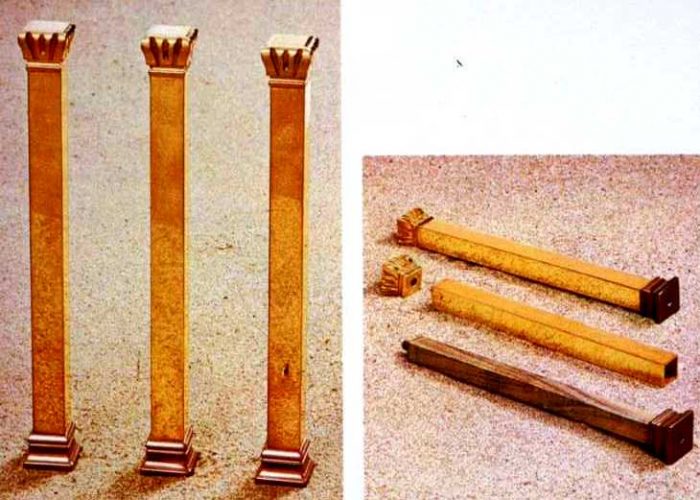
Nevertheless, the base is bronze representing that there is still more work to be done (John 13:10). When a person is born again, they receive a new spirit and new spiritual heart; however, they do not get a new mind. Consequently, it is their responsibility to undertake the disciplines that will change the way we think (1) from the way of this fallen world to the truth of God (Romans 12:2).
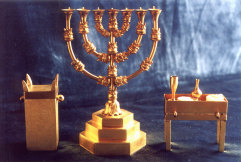
Recall, the Holy Place represents the Soul of man (1 Thessalonians 5:23), and the three items of furniture (i.e., Golden Lampstand (1), Table of Showbread (1), Golden Altar of Incense (1)) in the Holy Place represent the process that will lead to this Truth transformation. Therefore, the Holy Place’s curtain screen symbolically represents Jesus as “The Truth” (John 14:6).
We spiritually enter through the curtain screen into His court of the Holy Place with praise (i.e., singing songs that thank God for who He is to us). (Psalms 100:4)

Standing at the Golden Altar of Incense, we see the curtain veil or entrance of the Most Holy Place (i.e., Holy of Holies) woven of the same color scheme as the entrance to the Outer Court and the Holy Place. However, it has the addition of Cherubim (God’s Honor Guard Angels (1) – Genesis 3:24) embroidered on them (Exodus 26:31-33). The Cherubim guards represent the fact that entering the Most Holy Place is to enter into the presence of God, and you must be holy to enter (Leviticus 10:1-3). Recall, the temple’s veil in Jerusalem was split in two when Jesus died on the cross of Calvary (Mathew 27:50,51. Mark 15:37,38. Luke 23:45,46). This symbolically represented that a new way has been made by Jesus’ death to enter into the Most Holy Place (Hebrews 9:6-8. Hebrews 10:19,20).
There are four (i.e., number symbolic that this entrance is available to all that will “pray the price” and not just some Christian elite) posts or pillars used to support the linen veil at the entrance to the Most Holy Place. Furthermore, these posts are acacia wood covered with gold caps on top but with a silver base. Their hooks were made of gold and their sockets of silver. The silver bases (instead of bronze) represent the transformation that has taken place in a believer that has disciplined themselves in the Holy Place. However, the bases are not gold, which would represent sinless perfection (1) like God but rather are silver, representing that the believer is no longer choosing to sin as a lifestyle but still sins (1 John 3:4. 1 John 1:8). Nevertheless, the believer is walking so close to the Lord that any known sin is quickly confessed, repented, forgiven, and cleansed (1 John 1:7,9). Again, a believer at this point is so in love with God that hurting Him by intentionally sinning is unconscionable (Luke 7:47). Behind the veil in the presence of God, and those that have “prayed the price” are invited to a LIFE of oneness with God (John 17:21-23). That is, we experience the Life of God (Greek word “Zoe”). Therefore, the curtain veil to the Most Holy Place symbolically represents Jesus as “The Life” (John 14:6).
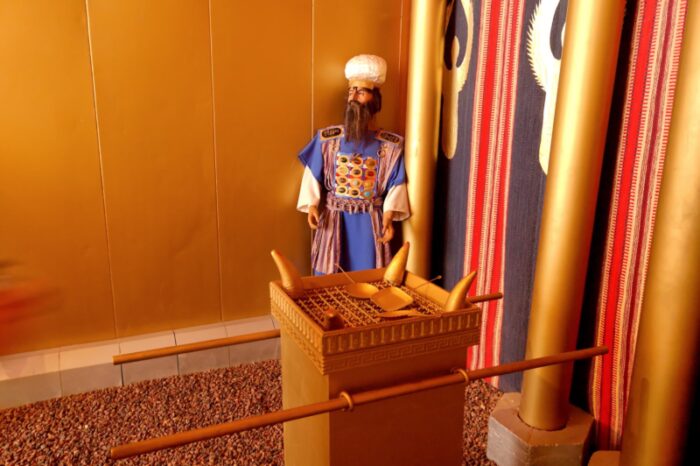
The veil separating the Holy Place from the Most Holy Place is also symbolic of man’s spiritual heart (1). Man’s spiritual heart connects the spirit and the soul, similar to the physical brain connecting the body and a man’s soul (Hebrews 4:12). The Holy of Holies represents the Spirit of man (1 Thessalonians 5:23). This is where God the Holy Spirit dwells in the Christian upon salvation (aka, baptized with the Holy Spirit) (1).

Again, we initiate entering into God’s presence with thanksgiving followed by praise (Psalms 100:4). Spiritually, our praise creates a Holy Place where God (who is Holiness Himself) can dwell among us (Psalms 22:3). The word praise in this verse is the Hebrew word “tehillah,” a spontaneous song that implies “go for it,” singing to God from the heart. This is the only type of praise recorded in the Bible that will create a throne for God. When we are in earnest praising God with our hands raised high, lost in adoration of our Lord and Savior, we are saying to Him – here are my hands made holy by you for the express purpose of creating your throne. Here we are, your servants, send me to carry your glory to the nations! (1 Timothy 2:8. Psalms 2:8) Then and only then are we invited behind the veil to worship the Lord in Spirit and Truth – the beauty of holiness!
The ark of the testimony was to be brought within the veil, and the veil was to divide between the Holy Place and the Most Holy. The Mercy Seat, or Throne, was to be put upon the Ark of the Testimony within the veil, in the Most Holy Place. The Mercy Seat is the lid of the ark (Exodus 25:10-22).

The Ark was a box, or chest, two and a half cubits long (43.75in/111.25cm), one and a half cubits wide (26.25in/66.75cm), and one and a half cubits high (2.19ft/0.6675m). It was overlaid with pure gold outside and inside. Within the Ark was to be placed “The Testimony which I shall give you,” the Lord told Moses (Exodus 25:21). In addition to the Tablets of the Covenant (i.e., The Ten Commandments), it contained a golden pot containing manna (Exodus 16:32-34) and Aaron’s rod that had budded (Numbers 17:1-11). The Ark of the Covenant’s content is confirmed to be these three items in the New Covenant as well (Hebrews 9:2-5).
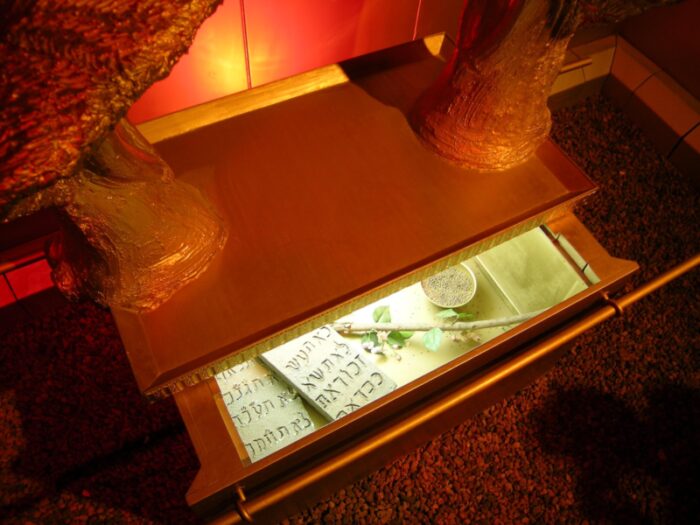
Each of the three things within the Ark represented man’s inability to do anything right without abiding in God (John 15:5). They represent the entire spectrum of mankind’s rejection of God.
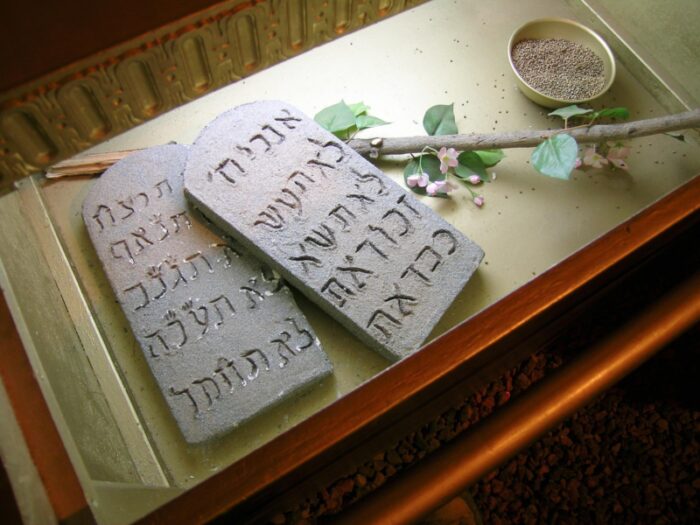
The Ark contained evidence of man’s failure to live holy before God; evidence of man rebelling against a loving and perfect God; evidence that God is the Great Provider, Leader, and Giver; evidence that fallen man is hopelessly flawed and in desperate need of a savior (4).
- Rejection of God’s provision, represented by the golden pot of manna. Manna (Hebrew for “what is it?” that was like coriander seed and was white (Exodus 16:31)) was given after the Israelites questioned God’s faithfulness to provide for them in the Wilderness of Sin. Furthermore, after manna was given, they rebelled against God’s instructions for gathering and using it (Exodus 16). This manna in the ark never went bad. Symbolically, God has made provision by giving the incorruptible Bread of Life – Jesus (John 6:32-35). However, sinful man continues to reject God’s bread from Heaven – Jesus!
- Rejection of God-appointed leadership, represented by Aaron’s rod. When Korah and others rebelled against God’s selection of Moses and Aaron, the rod of Aaron was caused to bud and produce blossoms and almonds overnight to show that God had picked Aaron and his descendants to be the priests. Symbolically, In Israel, the very first tree to awake from its winter sleep is the almond tree. God has all authority and can bring life from death (i.e., resurrection) (Matthew 28:18), which He did when He raised Jesus the firstborn from among the dead (i.e., not simply raised from the dead but born from death to life). (Revelations 1:5) However, sinful man continues to reject that authority and life.
- Rejection of God’s Law, represented by the stone (sapphire) (1) tablets. The Testimony or Ten Commandments have been rebelled against from their very inception. While Moses was on the mountain receiving them, the Israelites made an idol of gold and worshipped it, calling it God’s name – Yahweh! They broke the Law, thus breaking the Covenant, and Moses gave them an object lesson by breaking the tablets of stone on which the Ten Commandments were written. Symbolically, God has given us the law to lead us to understand our need for salvation (Galatians 3:21-25). The unbroken second set of tablets of stone on which the Ten Commandments were written represent Jesus, who never broke the law. However, sinful man continues to reject God’s law; thus, they do not fully understand the need for salvation by grace and faith (Ephesians 2:8,9).
Furthermore, the Ark points to Jesus Christ, the Savior of the World that was, is, and shall ever be!
- The manna in the golden bowl represents the life-sustaining food that God gives His people in Christ. The Lord sustained them with this mysterious bread when Israel was in the wilderness. Not knowing what it was, they called it “Manna” (lit. ‘What is it?’). When Jesus fed the five thousand, He said, “Moses did not give you the bread from heaven, but My Father gives you the true bread from heaven.…the bread of God is He who comes down from heaven and gives life to the world” (John 6:33). The flesh and blood of Christ is life-sustaining food for the believer. (6)
- The significance of Aaron’s rod is found in Numbers 16-17. Certain jealous men had called Aaron’s Priesthood into question. God commanded that the rebels take their rods and lay them out next to Aaron’s. The Lord made the rod of the man He had chosen to bud. Jesus is the great High Priest, chosen by His Father from all eternity. The rod was placed in the ark to show that Christ was the LORD’s chosen and anointed Priest (Isaiah 42:1; Heb. 5:4). (6)
- The Ten Commandments were also placed in the ark. This showed that the moral Law of God would forever stand before the presence of God. It also represented that the Law would be kept in Christ. He would fully obey all the commands of God for His people (Matthew 5:17; John 19:30). (6)

For a cover (or lid) over the Ark, Moses was to make a “Mercy Seat” (think Mercy Throne for God) of solid pure gold, with Cherubims, one at each end facing each other, and all in one piece. The Cherubims were to stretch forth their wings COVERING the Ark. The Mercy Seat (Mercy Throne) was the center of all, within the Holiest of all, the throne of the God of glory and where God would speak (Exodus 25:22), a place of covering and forgiving sin, the point over which rested the cloud and fire of God’s Presence.
The Hebrew word translated “mercy seat” is “kapporet” and means “a covering.” It is from the same root as the word “kaphar” translated as “atonement.” The only place in the Bible where the word “kapporet” is used is for “mercy seat.” This distinguishes the Mercy Throne as a PROTECTIVE COVERING. The Ark covering the place of forgiveness for sin and of the Testimony of the Lord. In the way, the ancients associated things, the covering of the Ark was the protective covering of the nation. Remember, God said in multiplied instances: “If you keep my covenant, I will cover and bless you” (Deuteronomy 28:1-14).
It was the judgment throne of the Invisible One, Israel’s King (Hebrews 9:5). The Greek word for “mercy seat” used here is “hilasterion” (hil-as-tay’-ree-on), meaning the place of appeasement. The same Greek word “hilasterion” is translated as “propitiation” in Romans 3:25, meaning Jesus is our Mercy Seat! (1) Furthermore, the Greek word for “propitiation” in 1 John 2:2 is “hilasmos” (hil-as-mos’), meaning that which appeases. Consequentially, Jesus is both the “place of appeasement” and “that which appeases” or said another way, Jesus is both the “Mercy Seat” and the “Sinless Sacrificial Lamb!” Jesus fully “God” and fully “Man.”
Jesus, God Himself became the appeasing demanded by His holiness and justice (1 John 4:10). God, the Righteous Judge, took upon Himself the penalty of the one whom He has judged guilty (i.e., man) so that man can have GRACE (i.e., unearned favor) to for God to show MERCY (i.e., provide whatever is needed to restore, heal, rescue, protect – save!). God has paid the penalty for our sin at the cross of Calvary, and based on this, God’s mercy is extended to all. That is, the judgment seat has become a Mercy Seat! (James 2:13)
It was the throne of Mercy. Everything in the Law of Moses centered in that Mercy Seat. All the sacrifices had to do with that Mercy Seat within the veil. All the shedding of the blood of offerings had to do with that one chief sprinkling of blood upon the Mercy Seat. The Ark and the Mercy Seat within the Holy of Holies symbolized the coming Word-made flesh, Jesus Christ. The “blood of sprinkling” symbolized the Lamb of God who bears away the world’s sin (Hebrews 9:11,12. Hebrews 9:22-26). MERCY!
The two Angels watching over the Mercy Seat, again the Mercy Seat represents Jesus, is a foreshadowing of the two Angels that would guard Jesus’ body, one at His head and one at His feet, so that it would not experience corruption or decay after the crucifixion (Acts 2:31. John 20:10-12)
Moses would go into the presence of God in the Holy of Holies, and the presence of God (i.e., the Glory of God) would permeate his body (Exodus 39:29,30. Exodus 34:35. 2 Corinthians 3:7). He would then exit the Holy of Holies and share the presence of God with his people. That is, Moses would go into God’s presence to “Bless Him” and would receive the power to “Bless them.”
Remember, under the Law, no one except the High Priest could go into the Holy of Holies and then just once a year on the Day of Atonement (Yom Kippur). However, New Testament believers are all priests unto God and have the right and responsibility to enter the Holy of Holies of our spirit (Revelations 1:5,6). This is where we drink the living water of the Holy Spirit and thirst no more (John 10:10-14). We do this in our quiet times via the Word of God and Prayer (John 10:9). When properly aligned to the Holy Spirit, the anointing of the Holy Spirit will flow out of the Holy of Holies (our spirit), the Holy Place (our soul), and the Outer Court (our body) to prepare the lost World to receive the presence of God (John 7:38. Acts 10:38).
Realize the Holy Spirit’s anointing is not an end in itself but rather the vehicle for bringing the presence of God! In the Old Testament, the priest first applied blood, then oil (Leviticus 14:14-17). We must die to ourselves before the life of God is demonstrated through us (Philippians 3:9-11). Again, we must first lay down our lives, self-will, and plan for our lives at the Golden Altar of Incense, and then, we will be ushered into the Holy of Holies to experience intimacy or union with God (John 17:21-23). There the Oil of Gladness – God the Holy Spirit (1) – will come upon us as we seek to obey Jesus (Hebrews 1:9). We will then go forth to minister in God’s ability to produce good works (John 15:7,8) and not our ability which produces dead works (Revelation 3:1,2).
Again, we chose to enter His gates with Thanksgiving and His courts with praise, but only God can choose to allow us into His precious presence for worship. No amount of trying or crying will allow us into His presence. Only the Phase V Christian (1) will be ushered into God’s presence since they have submitted to God’s destiny for their lives. Consequently, they now receive the anointing to fulfill God’s destiny for their lives. The destiny that He planned for them before they were born! (Jeremiah 1:5. Galatians 1:15)
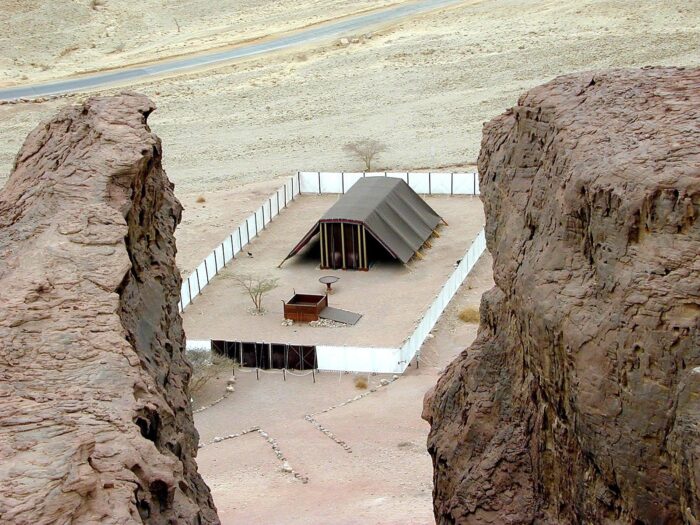
The Tabernacle, a Typology of the Incarnation of Jesus
In the third month of Sivan, Moses went up to meet God on Sinai, and during this time, he was given the plans for the Tabernacle and committed to having it constructed even as Mary had agreed to have Jesus formed in her womb. (Luke 1:38)
In the third month after the Israelites went out from the land of Egypt, on the very day, they came to the Desert of Sinai. After they journeyed from Rephidim, they came to the Desert of Sinai, and they camped in the desert; Israel camped there in front of the mountain. Moses went up to God, and the Lord called to him from the mountain, “Thus you will tell the house of Jacob, and declare to the people of Israel: (Exodus 19:1–3 NET)
The Holy Spirit constructed the Tabernacle components through Bezalel, Oholiab, and other skilled workers even as the Holy Spirit formed Jesus’ body through Mary’s womb. (Luke 1:35. Psalms 139:13)
Moses said to the Israelites, “See, the Lord has chosen Bezalel son of Uri, the son of Hur, of the tribe of Judah. He has filled him with the Spirit of God—with skill, with understanding, with knowledge, and in all kinds of work, to design artistic designs, to work in gold, in silver, and in bronze, and in cutting stones for their setting, and in cutting wood, to do work in every artistic craft. And he has put it in his heart to teach, he and Oholiab son of Ahisamach, of the tribe of Dan. He has filled them with skill to do all kinds of work as craftsmen, as designers, as embroiderers in blue, purple, and scarlet yarn and in fine linen, and as weavers. They are craftsmen in all the work and artistic designers. So Bezalel and Oholiab and every skilled person in whom the Lord has put skill and ability to know how to do all the work for the service of the sanctuary are to do the work according to all that the Lord has commanded.” (Exodus 35:30–36:1 NET)
Nine months later, God directed Moses to set up (birth) the Tabernacle on the first day of the first month of Nisan even as Mary travailed in labor to birth Jesus on that same date years later (1). (Luke 2:6)
Then the Lord spoke to Moses: “On the first day of the first month you are to set up the tabernacle, the tent of meeting. You are to place the ark of the testimony in it and shield the ark with the special curtain. (Exodus 40:1–3 NET)
Then God filled the Tabernacle with Himself. God tabernacled with humanity for the first time on Nisan 1, the same month and day Jesus was born (1) and tabernacled with humanity (1)! (Luke 2:7. John 1:14)
And he set up the courtyard around the tabernacle and the altar, and put the curtain at the gate of the courtyard. So Moses finished the work. Then the cloud covered the tent of meeting, and the glory of the Lord filled the tabernacle. Moses was not able to enter the tent of meeting because the cloud settled on it and the glory of the Lord filled the tabernacle. (Exodus 40:33–35 NET)
And the Word, entering a new mode of existence, became flesh, and lived in a tent [His physical body] among us. And we gazed with attentive and careful regard and spiritual perception at His glory, a glory such as that of a uniquely-begotten Son from the Father, full of grace and truth. (John 1:14 WUESTNT)
The Tabernacle of Moses Series:
- God’s Heavenly Pattern for our Spiritual Transformation – Part I: The Outer Court
- God’s Heavenly Pattern for our Spiritual Transformation – Part II: The Holy Place – Gold Lampstand
- God’s Heavenly Pattern for our Spiritual Transformation – Part III: The Holy Place – Table of Showbread
- God’s Heavenly Pattern for our Spiritual Transformation – Part IV: The Holy Place – Golden Altar of Incense
- God’s Heavenly Pattern for our Spiritual Transformation – Part V: The Most Holy Place
- God’s Heavenly Pattern for our Spiritual Transformation – Part VI: The Priestly Garments
- God’s Heavenly Pattern for our Spiritual Transformation – Part VII: Our Great High Priest
- God’s Heavenly Pattern for our Spiritual Transformation – Part VIII: The Women of the Tabernacle
Sacrifices and Offerings of the Old Covenant Series:
- The Fire Sacrifices and Offerings of Israel – Introduction
- The Fire Sacrifices and Offerings of Israel – The “Whole” Burnt Offering
- The Fire Sacrifices and Offerings of Israel – The Meal Offering
- The Fire Sacrifices and Offerings of Israel – The Peace Offering
- The Fire Sacrifices and Offerings of Israel – The Sin Offering
- The Fire Sacrifices and Offerings of Israel – The Trespass Offering
- The Fire Sacrifices and Offerings of Israel – The Red Heifer Offering
- The Fire Sacrifices and Offerings of Israel – The Ordination Offering
Shalom
(Security, Wholeness, Success)
Peace
Then he said to them, “Therefore every expert in the law who has been trained for the kingdom of heaven is like the owner of a house who brings out of his treasure what is new and old.” (Matthew 13:52 NET)
(1) Select the link to open another article with additional information in a new tab.
(2) Tabernacle Model Pictures from Bolen, T. Pictorial Library of Bible Lands, Volumes 1-20 Purchased from https://www.bibleplaces.com and used with permission.
(3) The cubit’s length was based on the distance from the elbow to the fingertips, so it varied between different ancient groups of people. Though the original cubit length is uncertain, I have used the Hebrew short cubit (17.5 inches/44.5 cm) for this article (Ezekiel 43:13).
Cubic Type Inches (centimeters)
- Hebrew (short) 17.5 (44.5)
- Egyptian 17.6 (44.7)
- Common (short) 18 (45.7)
- Babylonian (long) 19.8 (50.3)
- Hebrew (long) 20.4 (51.8)
- Egyptian (long) 20.6 (52.3)
(4) The children of Israel, at times, had to rid themselves of items that had been of help and value to them. The bronze serpent, which had been a means of their healing, had to be smashed (2 Kings 18:4). Aaron’s rod and the container of manna, both symbols, and reminders of God’s deliverance and provision, were no longer in the Ark of the Covenant when Solomon took it into the temple (1 Kings 8:9). Sadly even those things God has given us as a blessing, encouragement, or help can become a hindrance to our relationship with Him. We tend to hold on to so much, both materially and spiritually, things that perhaps give us comfort and security, which should be found by drawing closer to God and deepening our relationship with him.
(Ellel Ministries International, Seeds of the Kingdom, February 13, 2013, “De-cluttering” by Malcolm Wood)
(5) Timna Park (1), Eilot Regional Council 88820
(6) https://feedingonchrist.org/the-symbolism-of-the-ark-of-the-covenant/
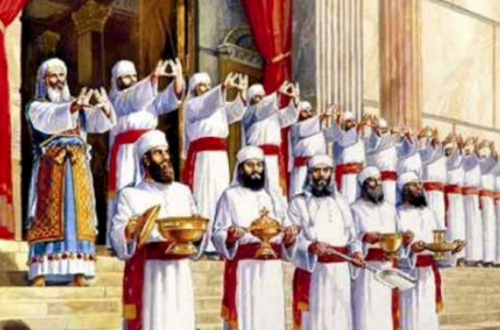
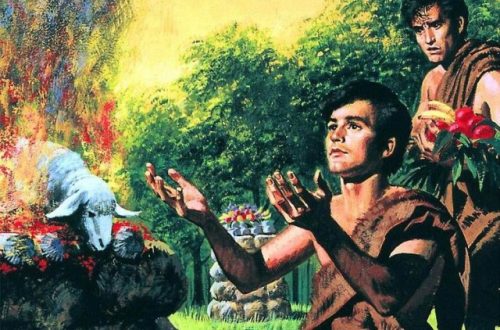

3 Comments
SonShine
Awesome
I have always loved the study of the Tabernacle. Don’t you just wonder how the Israelite could look upon it and then reject it? I have never been able to grasp that. Thank you for such an indepth study and reflection.
GEA
Charlie Hunke
Amazing, the symbolizing of
Amazing, the symbolizing of God's attributes displayed in His Tabernacle must have been mysterious to the onlooker in those times. Brings to mind that in these days, His attributes displayed in His Human Tabernacles are just as mysterious to onlookers. Maybe even just as mysterious to us, those that have chosen Jesus. The more understanding, the more respect and thankfullness, in a God who reveals Himself in such perfect and well defined ways, that is, once we have eyes to see.
Emailog
Priestly garments
I have been teaching my small bible class about Moses tabernacle. Thank you so much for the additional information. I love to read your articles. I am looking for the meaning of the priestly garments. I have come to believe that everything in the OT is symbol of the new covenant.
I would so appreciate if you can point me in the right direction so I can learn the meaning of the priestly garments.